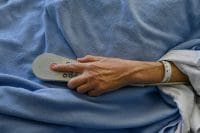While eating disorders have been widely publicized for decades, far less attention has been given to a related condition called body dysmorphic disorder, or BDD.
Body dysmorphic disorder is often hidden from public view due to the shame people feel about one or more parts of their body, yet it is a devastating, debilitating psychological condition. People with the disorder suffer from obsessive thoughts and repetitive behaviors related to their appearance.
Whereas people with eating disorders might view their underweight body as too fat, those with body dysmorphic disorder see themselves as ugly or disfigured even though they appear normal or attractive to others.
Helping patients who harm themselves
International Nurses Society on Addictions: Preventing and managing addictive behavior
Body dysmorphic disorder is more common in both men and women than bulimia or anorexia. About 2.5% of women and 2.2% of men in the U.S. meet the criteria for body dysmorphic disorder – that’s higher than the prevalence of generalized anxiety disorder, schizophrenia or bipolar disorder in the general population.
For comparison, at any point in time, bulimia is seen in roughly 1.5% of women and 0.5% of men in the U.S., and anorexia in 0.35% of women and 0.1% of men.
We are a team of communication and mental health researchers and clinicians from Colorado State University Global, Hofstra Medical School and the University of Toronto. One of us, Eva Fisher, lived with the disorder for almost 15 years before getting help and recovering. My book, titled “The BDD Family,” provides insights into my daily struggles with body dysmorphic disorder along with information about diagnosis and treatment.
In our view, body dysmorphic disorder needs to be better understood and publicized so that more people suffering from the condition can be properly diagnosed and treated.
Comparison between BDD and eating disorders
People with body dysmorphic disorder and those with eating disorders share similar negative emotions such as shame, disgust and anger about their appearance. They also engage in some similar behaviors, such as mirror checking, taking photos to check themselves, seeking reassurance from others about their appearance, and using clothing to camouflage or conceal perceived defects.
People who suffer from these disorders commonly avoid places and activities due to self-consciousness about their appearance. In addition, those with eating disorders and body dysmorphic disorder may lack the knowledge that their body image beliefs are distorted.
Depression is common in people with body dysmorphic disorder, and they have a higher rate of suicidality than those with eating disorders, including thoughts about committing suicide and suicide attempts. Although both eating disorders and body dysmorphic disorder can be severe and life-threatening, people with body dysmorphic disorder on average experience more impairment in daily functioning than those with eating disorders.
A personal view
My (Eva’s) body dysmorphic disorder symptoms started at age 16. Some causes could have been childhood bullying and perfectionism about my appearance. I would obsess about the shape and size of my nose for more than eight hours a day and constantly compare my appearance to models in fashion magazines.
I was convinced that others were judging me negatively because of my nose, which I perceived to be fat and ugly. I hated my nose so much that I didn’t want to get married or have children because I feared they would inherit it.
Even after getting plastic surgery at age 18 to make my nose thinner, I still hated it. This is a very common outcome for people with the disorder who undergo cosmetic surgery procedures.
Research indicates that 66% of people with body dysmorphic disorder have received cosmetic or dermatological treatment. However, even when people feel better about one part of their body after surgery, the image obsession often moves to one or more other body parts.
Some patients will have multiple procedures on the same body part. Other people are so disappointed by the results of their surgery that they want to commit suicide.
Tragically, many people with body dysmorphic disorder think about killing themselves, and others attempt to take their own lives. Approximately 80% of people with body dysmorphic disorder experience lifetime suicidal ideation, and 24% to 28% have attempted suicide. Often, they are young men and women who feel so hopeless about their perceived appearance defects that suicide seems like the only way to end their suffering.
When appearance concerns become problematic
So how is body dysmorphic disorder different from normal appearance concerns? Researchers have found evidence that while appearance dissatisfaction can range in severity, there is a distinct group of people with much higher appearance concerns, many of whom likely have the disorder. They feel much worse about their appearance than those with normal appearance concerns and experience greater anxiety, depression, shame and self-disgust about some aspects of their appearance.
About one-third of people with the disorder obsess about their perceived flaws for one to three hours a day, nearly 40% for three to eight hours a day and about a quarter for more than eight hours a day. Most people with body dysmorphic disorder know they spend too much time thinking about their appearance, but others with the condition mistakenly believe that it’s entirely normal to worry about their appearance for hours every day.
Common body dysmorphic disorder behaviors include, from most to least common:
- camouflaging the perceived defects with clothing and makeup
- comparing one’s appearance to others
- checking one’s appearance in mirrors and other reflective surfaces
- seeking cosmetic treatments such as surgery and dermatology
- repeatedly taking photos to check one’s appearance
- seeking reassurance from others about the perceived flaw or convincing others that it is unattractive
- touching the perceived flaw
- excessively changing clothes
- dieting and skin picking to improve appearance
- engaging in excessive exercise, including excessive weightlifting
Discovering the causes of body dysmorphic disorder
The exact causes of body dysmorphic disorder are unknown. Possible developmental causes include genetic factors, childhood bullying and childhood teasing about appearance and competency, as well as childhood maltreatment and trauma. Other factors that could play a role include growing up in a family with an emphasis on appearance, perfectionist standards concerning appearance and exposure to high ideals of attractiveness and beauty in the mass media.
Common personality traits among people with body dysmorphic disorder include perfectionism along with shyness, social anxiety, low self-esteem and sensitivity to rejection and criticism.
Researchers have found that people with the disorder may have abnormalities in brain functioning. For instance, one study found that people with body dysmorphic disorder, as well as those with anorexia, have an information processing bias toward more detailed visual information rather than viewing images globally – in other words, seeing the trees rather than the forest. This suggests that abnormalities in the brain’s visual system could contribute to the distortions that those with body dysmorphic disorder and anorexia experience.
Effective treatments
Fortunately, there are effective treatments for people with body dysmorphic disorder. Cognitive behavioral therapy and medication are both used to treat the disorder.
During cognitive behavioral therapy, therapists work with patients to help them modify intrusive thoughts and beliefs about physical appearance and to eliminate problematic behaviors associated with body image, such as mirror checking and reassurance seeking.
Medications called selective serotonin reuptake inhibitors, or SSRIs, such as Prozac and Zoloft can reduce or eliminate cognitive distortions, depression, anxiety, negative beliefs and compulsive behaviors. They can also increase levels of insight and improve daily functioning.
I (Eva) worked with a psychologist and psychiatrist to combat the depression and anxiety caused by my appearance concerns. Fortunately, both the medication and therapy were effective in reducing my negative feelings and compulsive behaviors.
Two years after I started treatment, my symptoms lessened and became manageable. Today I facilitate two online support groups and encourage people to learn more about the disorder. Group members provide support and comfort to others who understand their daily struggles. They also share advice about getting help for this common but little known body image disorder.
More information about diagnosis and treatment for body dysmorphic disorder is available on the International OCD Foundation BDD site.![]()
![]()
Eva Fisher, Communication Faculty Member, Colorado State University Global; Fugen Neziroglu, Clinical Assistant Professor of Psychiatry, School of Medicine, Hofstra University, and Jamie Feusner, Professor of Psychiatry and Clinicial Scientist at the Center for Addiction and Mental Health, University of Toronto
This article is republished from The Conversation under a Creative Commons license. Read the original article.


















